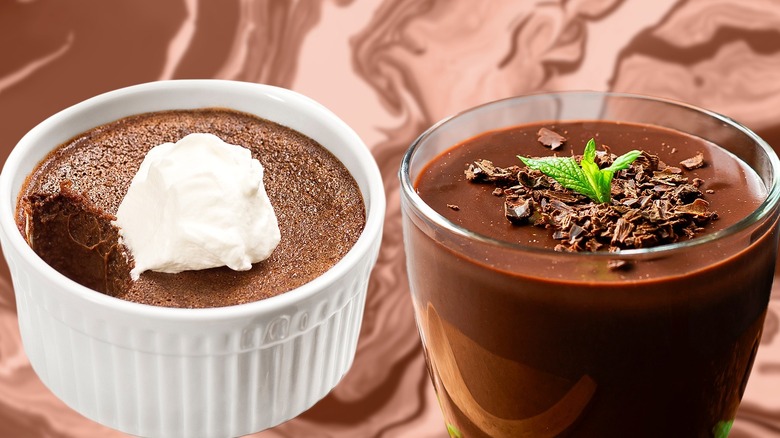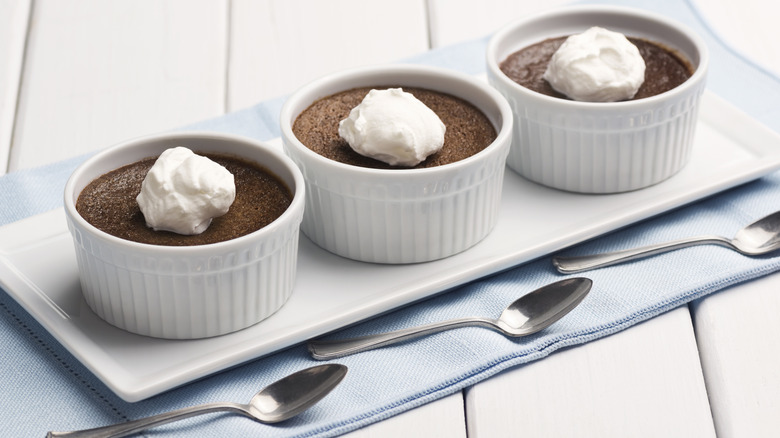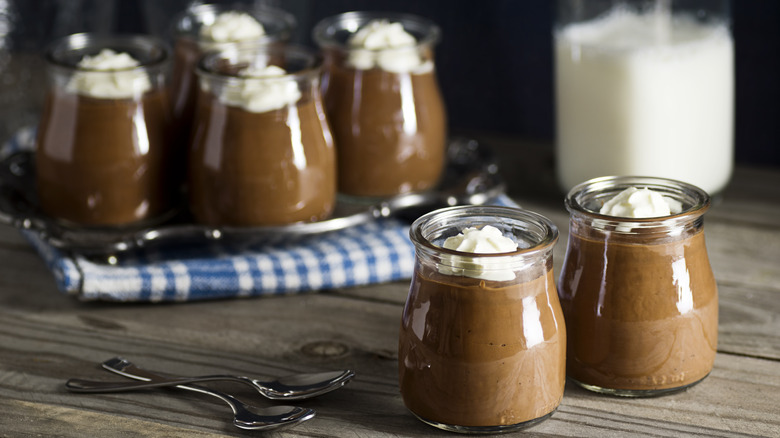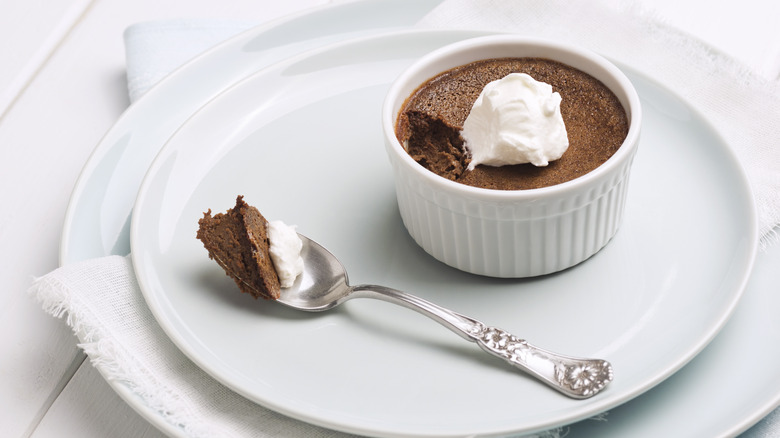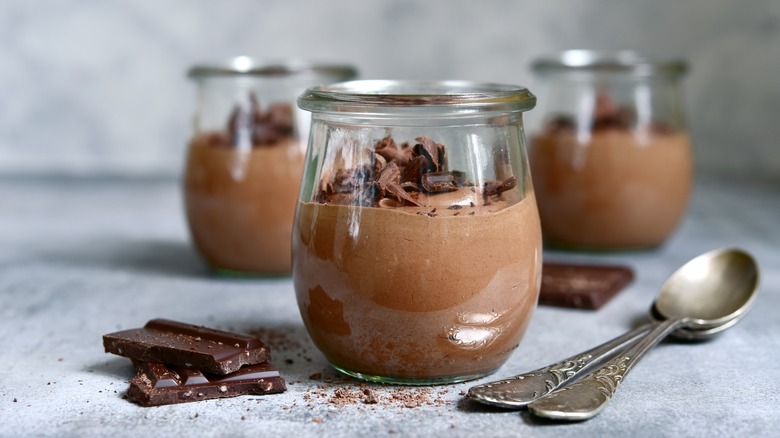This Is The Actual Difference Between Pots De Creme And Pudding
It's hard to deny the allure of a chocolate dessert. From a deliciously moist death by chocolate cake to souffle or a chocolate caramel tart, there are many vessels for the beloved sweet. Yet, those after a more textural experience — especially an ultra-smooth one — should look into the types of custard desserts that feature chocolate.
In addition to the creative delights of a mocha-flavored crème brûlée and a chocolate-tinged clafoutis, two dependable, classic options are pots de creme and a good old-fashioned chocolate pudding. Both offer that velvety goodness, ready to be spooned out one bite at a time. But despite their similar appearance, they pack some key differences in taste and preparation.
Chocolate puddings incorporate a starch — typically corn starch — which stabilizes the entire dessert, creating its quintessential thick texture. On the other hand, pots de creme only use eggs to attain their consistency, which makes their components more set in stone. Their resultant flavor is more chocolate-forward — however, it's harder to pack in additional flavorings. Regardless of which one you choose, there will be an ample dose of chocolate taste, so it's hard to go wrong.
What are pots de creme?
Translating to "jars of cream," this French dessert traces back to the 17th century. It was a food frequently enjoyed in formal settings, with a dainty vessel designed specifically for the dish emerging in the 18th century. The food requires an easily found assortment of ingredients: eggs, sugar, chocolate, and cream. Yet, like a classic crème brûlée, its magic lies in the deft combination of components to create a rich and refined dish. The dessert's decadent texture sits somewhere between a mousse and a pudding, complemented by a clean chocolate flavor.
To achieve such a result, pots de creme are prepared in a warm water bath in the oven. While more laborious, this preparation method is necessary to set the custard. Prior, all of the ingredients are mixed over heat, with the eggs carefully added to avoid curdling. The chocolate creations simmer in ramekins for around half an hour before chilling in the fridge — just like pudding. Pots de creme are served with a dollop of whipped cream and enjoyed by the spoonful, making them an incredible post-dinner treat.
What is pudding?
The term pudding refers to a broad range of dishes — both sweet and savory — all encompassed by a dense yet moist texture. In the U.S., the term brings to mind thickened desserts in particular, with the chocolate version being an especially nostalgic rendition. This dessert emerged in the 19th century, with its debut in an instant boxed form in the 1930s really bringing it to the mainstream. Conversely, the pudding label is applied more broadly in the U.K.
Most chocolate pudding recipes employ corn starch, which is the thickener of choice for the dish. The ingredient is combined with dairy and, oftentimes, eggs, as well as sugar and salt. When it comes to the namesake flavoring, some renditions rely on only cocoa powder, although most also integrate chopped chocolate to amplify the flavor. Fat is added in the form of butter, cream, of both. The components are melded together over heat, but there's no water bath — once everything's melded together, it's chilled to completion. You'll want to make sure the result is nice and thick, so wait out the refrigeration time patiently and brush up on the tips you need for homemade pudding. Then, serve the chocolate pudding with a traditional dollop of whipped cream on top. With a storage time of several days, it's the ideal treat to make in advance, ready for enjoyment at a moment's notice.
Pots de creme employ only eggs for thickness
Pots de creme leave out any starchy ingredients, instead building thickness through the inclusion of egg yolks coupled with an extended cooking duration. The dish emerges through a patient balancing act of cream, eggs, and a prolonged water bath. Undercooked or under-chilled, the pots de creme will be too runny. Plus, unlike a pudding, it's possible to overcook the dish in the oven. Such a move results in an overly grainy custard, a far cry from the decadently smooth dish people want.
Conversely, with chocolate pudding's inclusion of corn starch, the thickening is much more dependable. The ingredient is sure to solidify the dish, but the consistency may not always be ideal. Additionally, the powder mellows out some of the chocolate flavors. As a result, bakers typically throw in some eggs yolks, too, amplifying chocolate pudding's custard-like texture. This pairing of thickeners is the best way to create an easy pudding, without sacrificing refinement.
Chocolate puddings come in many variations
Chocolate pudding's more stable consistency opens it up to a wide range of interpretations. Many experiment with the stabilizer, abandoning the corn starch in favor of modern ingenuities. For something completely vegan, it might be made of avocado and coconut cream, as well as unorthodox tofu-based vegan versions. Others forgo dairy in favor of oat or other types of plant-based milks. Such allowances for dairy-free or egg-free creations allow for the dish to be made for a range of dietary preferences. Plus, it showcases the full stretch of the format; at its core, chocolate pudding simply refers to a thick, cocoa-flavored creation. So whether it's a dash of fresh mint or some hot chilis, many flavors are welcomed into the ramekin.
On the other hand, most pots de creme recipes keep it classic, sticking to eggs and dairy for their base. The dish's minimal medley of components highlights the intrinsic flavor of the chocolate, making it a great dessert for high quality specimens. Some bakers do like imbuing an additional spin — like a dash of vanilla, caramel, or coffee — but not enough to override the dominant chocolate flavor. After all, it's precisely this dessert's cocoa-forward palate that makes the dish so special and distinct from its pudding counterpart.
